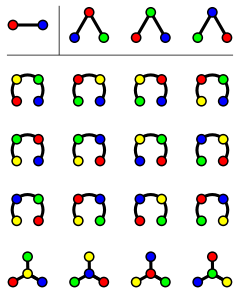Graph enumeration

 tree with 2 vertices,
tree with 2 vertices,
 trees with 3 vertices and
trees with 3 vertices and  trees with 4 vertices.
trees with 4 vertices.In combinatorics, an area of mathematics, graph enumeration describes a class of combinatorial enumeration problems in which one must count undirected or directed graphs of certain types, typically as a function of the number of vertices of the graph.[1] These problems may be solved either exactly (as an algebraic enumeration problem) or asymptotically. The pioneers in this area of mathematics were Pólya,[2] Cayley [3] and Redfield.[4]
Labeled vs unlabeled problems
In some graphical enumeration problems, the vertices of the graph are considered to be labeled in such a way as to be distinguishable from each other, while in other problems any permutation of the vertices is considered to form the same graph. In general, labeled problems tend to be easier to solve than unlabeled problems.[5] As with combinatorial enumeration more generally, the Pólya enumeration theorem is an important tool for dealing with symmetries such as this.
Exact enumeration formulas
Some important results in this area include the following.
- The number of labeled n-vertex undirected graphs is 2n(n − 1)/2.[6]
- The number of labeled n-vertex directed graphs is 2n(n − 1).[7]
- The number Cn of connected labeled n-vertex undirected graphs satisfies the recurrence relation[8]
- from which one may easily calculate, for n = 1, 2, 3, ..., that the values for Cn are
- The number of labeled n-vertex free trees is nn − 2 (Cayley's formula).
- The number of unlabeled n-vertex caterpillars is[9]
References
- ↑ Harary, Frank; Palmer, Edgar M. (1973). Graphical Enumeration. Academic Press. ISBN 0-12-324245-2.
- ↑ Kombinatorische Anzahlbestimmungen für Gruppen, Graphen und chemische Verbindungen. Acta Math. 68 (1937), 145-254
- ↑ "Cayley, Arthur (CLY838A)". A Cambridge Alumni Database. University of Cambridge.
- ↑ The theory of group-reduced distributions. American J. Math. 49 (1927), 433-455.
- ↑ Harary and Palmer, p. 1.
- ↑ Harary and Palmer, p. 3.
- ↑ Harary and Palmer, p. 5.
- ↑ Harary and Palmer, p. 7.
- ↑ Harary, Frank; Schwenk, Allen J. (1973), "The number of caterpillars", Discrete Mathematics 6 (4): 359–365, doi:10.1016/0012-365x(73)90067-8.

